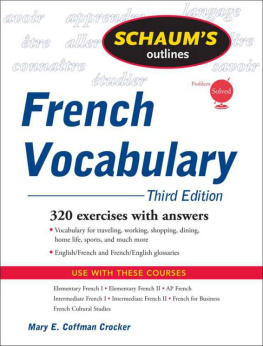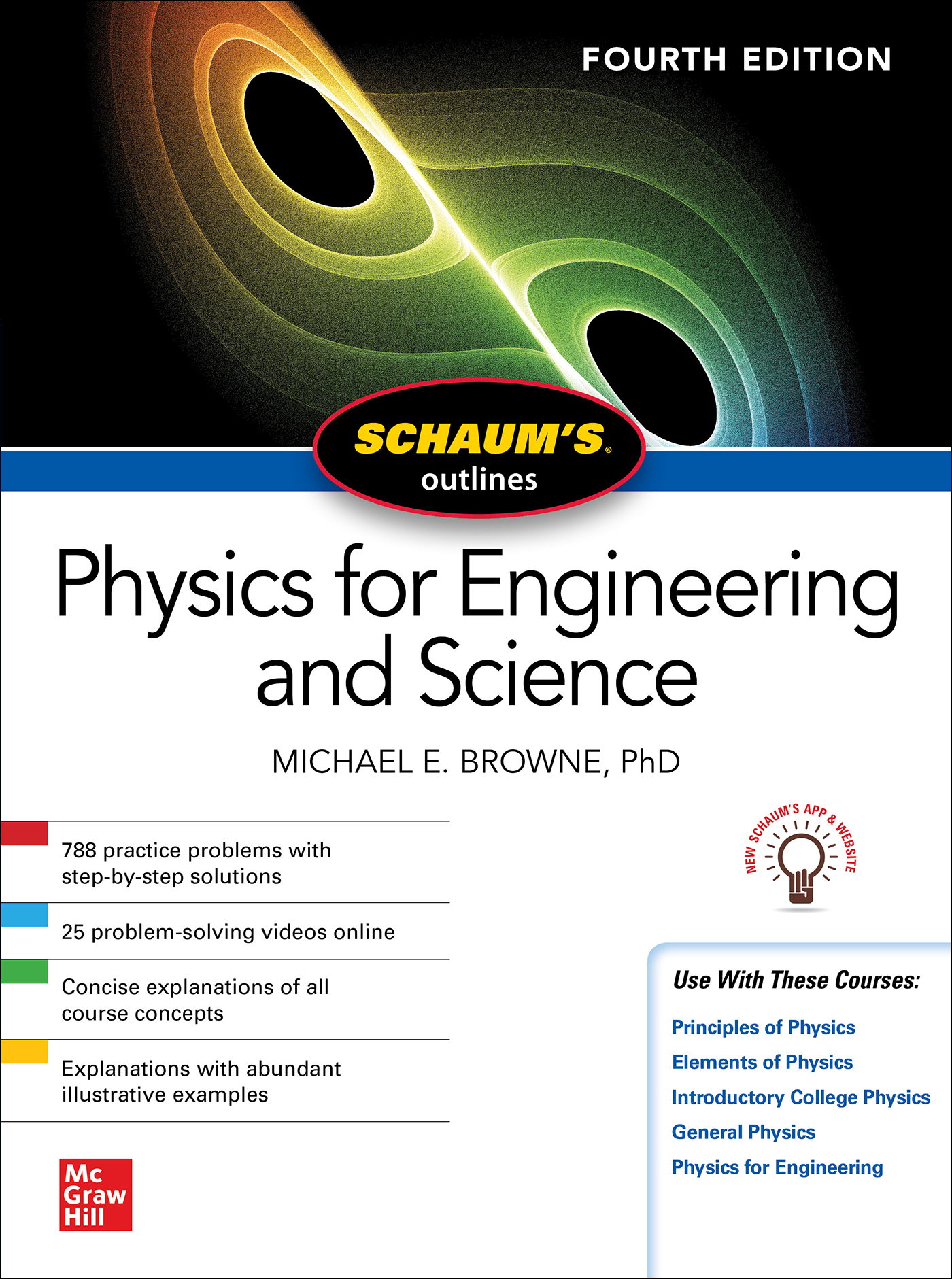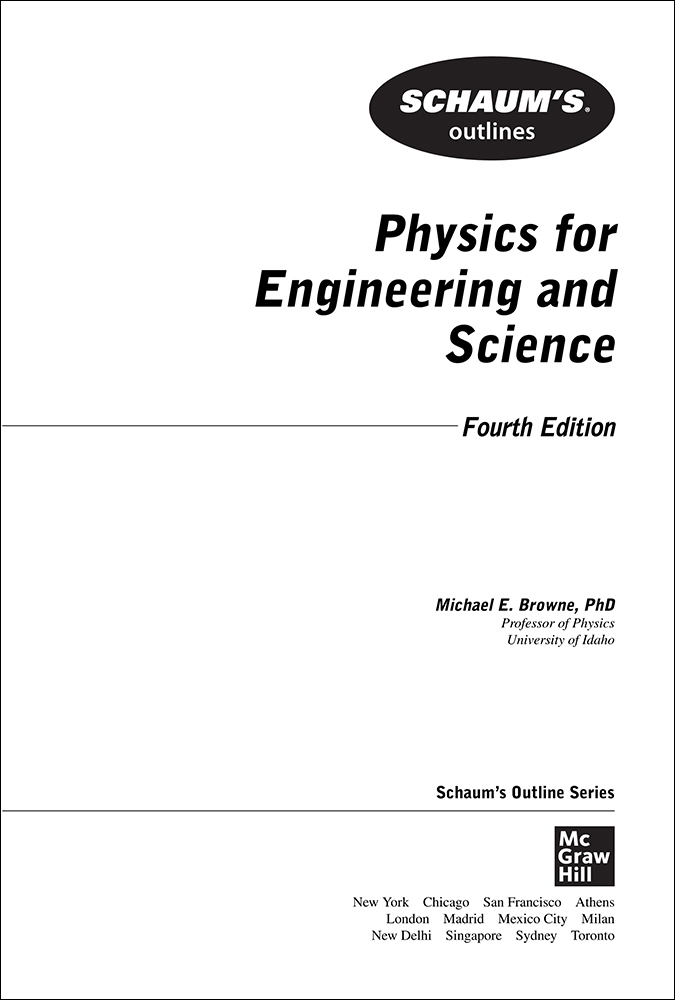MICHAEL E. BROWNE is a graduate of the University of California, Berkeley, where he received BS (engineering) and PhD (physics) degrees. He was a research scientist and manager at the Lockheed Research Laboratories, subsequently serving as professor of physics and chairman of the physics department at the University of Idaho. He has conducted research in solid-state physics and in science education, his most recent activity. His teaching experience ranges from introductory physics to graduate classes. He has published numerous research articles and coauthored two textbooks.
Copyright 2020, 2013, 2010, 1999 by McGraw-Hill Education. All rights reserved. Except as permitted under the United States Copyright Act of 1976, no part of this publication may be reproduced or distributed in any form or by any means, or stored in a database or retrieval system, without the prior written permission of the publisher.
ISBN: 978-1-26-045384-3
MHID: 1-26-045384-7
The material in this eBook also appears in the print version of this title: ISBN: 978-1-26-045383-6, MHID: 1-26-045383-9.
eBook conversion by codeMantra
Version 1.0
All trademarks are trademarks of their respective owners. Rather than put a trademark symbol after every occurrence of a trademarked name, we use names in an editorial fashion only, and to the benefit of the trademark owner, with no intention of infringement of the trademark. Where such designations appear in this book, they have been printed with initial caps.
McGraw-Hill Education eBooks are available at special quantity discounts to use as premiums and sales promotions or for use in corporate training programs. To contact a representative, please visit the Contact Us page at www.mhprofessional.com.
McGraw-Hill Education, the McGraw-Hill Education logo, Schaums and related trade dress are trademarks or registered trademarks of McGraw-Hill Education and/or its affiliates in the United States and other countries and may not be used without written permission. All other trademarks are the property of their respective owners. McGraw-Hill Education is not associated with any product or vendor mentioned in this book.
TERMS OF USE
This is a copyrighted work and McGraw-Hill Education and its licensors reserve all rights in and to the work. Use of this work is subject to these terms. Except as permitted under the Copyright Act of 1976 and the right to store and retrieve one copy of the work, you may not decompile, disassemble, reverse engineer, reproduce, modify, create derivative works based upon, transmit, distribute, disseminate, sell, publish or sublicense the work or any part of it without McGraw-Hill Educations prior consent. You may use the work for your own noncommercial and personal use; any other use of the work is strictly prohibited. Your right to use the work may be terminated if you fail to comply with these terms.
THE WORK IS PROVIDED AS IS. McGRAW-HILL EDUCATION AND ITS LICENSORS MAKE NO GUARANTEES OR WARRANTIES AS TO THE ACCURACY, ADEQUACY OR COMPLETENESS OF OR RESULTS TO BE OBTAINED FROM USING THE WORK, INCLUDING ANY INFORMATION THAT CAN BE ACCESSED THROUGH THE WORK VIA HYPERLINK OR OTHERWISE, AND EXPRESSLY DISCLAIM ANY WARRANTY, EXPRESS OR IMPLIED, INCLUDING BUT NOT LIMITED TO IMPLIED WARRANTIES OF MERCHANTABILITY OR FITNESS FOR A PARTICULAR PURPOSE. McGraw-Hill Education and its licensors do not warrant or guarantee that the functions contained in the work will meet your requirements or that its operation will be uninterrupted or error free. Neither McGraw-Hill Education nor its licensors shall be liable to you or anyone else for any inaccuracy, error or omission, regardless of cause, in the work or for any damages resulting therefrom. McGraw-Hill Education has no responsibility for the content of any information accessed through the work. Under no circumstances shall McGraw-Hill Education and/or its licensors be liable for any indirect, incidental, special, punitive, consequential or similar damages that result from the use of or inability to use the work, even if any of them has been advised of the possibility of such damages. This limitation of liability shall apply to any claim or cause whatsoever whether such claim or cause arises in contract, tort or otherwise.
This book is dedicated to Marguerite, whose love, encouragement, and help made so many things possible .
Preface
This book is intended for students who are taking, or who have already taken, calculus and who may be taking a formal physics class for the first time. A background in high school-level algebra, geometry, and trigonometry is assumed. The book will be a valuable supplemental text for students presently enrolled in a calculus-based physics course for engineering and science students. It is much more compact than traditional textbooks, and it stresses problem solving and provides many worked examples. Secondly, the book will be useful as a text for a person reviewing or strengthening his or her knowledge of physics, perhaps in preparation for a professional examination. The treatment is suitable for a person wishing to study physics on his or her own without enrolling in a formal course. The narrative discussion and explanations are sufficiently clear and complete so that the book may be used either as a text, or as a supplement to a longer text.
Life science students will find the approach here valuable, since the treatment is more rigorous than that in many liberal arts textbooks. Many examples relevant to medicine are presented. Although calculus is used, it is reviewed and explained when first encountered.
The crux of learning physics is to actually work through problems. In using this book, you should be an active learner. Try to work each of the sample problems and examples as you go along. Refer to the solutions only if you get stuck. As they say in training to run a marathon, no pain, no gain. Only in the dictionary does success come before work. Learning about physics is a fascinating endeavor, and I hope you find it as much fun as I have.
I am deeply indebted to Luanne Semler for the outstanding work she did in typing the manuscript. Judy Breedlove made valuable contributions to the graphics work, and her efforts are much appreciated. My editors at McGraw-Hill were most helpful. Arthur Biderman helped launch the project, and Mary Loebig Giles guided it through to successful completion. The second edition of this book would not have reached fruition without the dedication, effort and talent of Hannah Turner, Editorial Manager at Techset Composition Ltd, in England. She is a wonder. I owe her.
M ICHAEL E. B ROWNE
Contents
*The laptop icon next to an exercise indicates that the exercise is also available as a video with step-by-step instructions. These videos are available on the website by following the instructions on the inside front cover.
CHAPTER 1
Review of Mathematics
Prior to studying this introductory physics course, a student should have completed high school courses in algebra, geometry, and trigonometry. Students should have, as a minimum, been studying calculus concurrently. By the second half of the course students should understand the basics of integral calculus. Most difficulties encountered in studying physics result from inadequate preparation in mathematics, so students should review this chapter if they have a weak background.
1.1 Symbols, Scientific Notation, and Significant Figures





